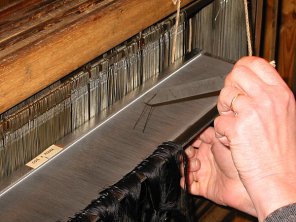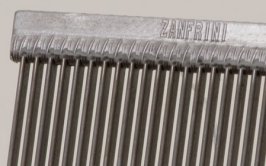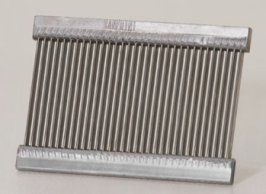- Home
- Resurrection ▾
-
Learn ▾
- Free library
- Glossary
- Documents
- Initiation
-
Shaped fabrics
- Introduction
- Popularization
- Definitions
- Le métier de façonné
- Principes du façonné
- Mécaniques de façonné
- Le jeu des crochets
- Les cartons
- Chaîne des cartons
- Mécanique 104 en détail
- Pour en finir
- Montage façonné
- Empoutage 1/3
- Empoutage 2/3
- Empoutage 3/3
- Punching, hanging and dip
- Autres façonnés
- Façonnés et Islam
-
Cours de tissage 1912
- Bâti d'un métier
- Le rouleau arrière
- Les bascules
- Formation du pas
- Position de organes
- Mécanique 104 Jacquard
- Fonctionnement 104
- Lisage des cartons
- Le battant du métier
- Le régulateur
- Réduction et régulateur
- Mise au métier d'une chaîne
- Mise en route du métier
- Navettes à soie
- Battage
- Ourdissage mécanique
- Préparation chaînes et trames
- Equipment ▾
- Chronicles ▾
- Fabrics ▾
- Techniques ▾
- Culture ▾
- Language ▾

The space between two blades takes the name of tooth. It is in this interval that the warp threads are passed. The name set of the reed is given to the quantity of intervals or, in other words, to the quantity of teeth (spaces) contained in a centimeter or a decimeter.
The set of the reed is a ratio between the number of threads in the warp, the number of threads in teeth and the width of the fabric, based on the centimeter.
Thus, a warp of 5000 threads is to be distributed in 50 cm at the rate of 4 thread per tooth.
What will be the set of the reed if the threads are placed by 4 in the teeth of the reed?5000 threads / 50 cm = 100 threads / cm in the fabric100 threads per cm of fabric divided by 4 teeth = 25 teeth per cm of reed
(5000/50) / 4 = 25.This is the set of the reed.
The comb performs three functions in the fabric:
1- It regularly distributes the warp threads in a given width, either individually or collectively.2- It serves as a support and guide to the shuttle in its course to deposit the weft.3- It strikes and thus cups the weft to constitute the fabric.
The passage of the threads in the reed.
One or more warp threads are introduced successively into each tooth by means of a tool called a reed hook in which the warp yarn (s) to be stitched is hooked and then the reed hook is removed, which has the effect of reeding the threads who are hooked.
One can very clearly distinguish the wire setting the space between two teeth, embedded in the tin of the weld.


The reed is an indispensable part for weaving. It consists of a succession of thin, flat steel plates, fixed between two half-round rods called "crystèles". The "crystèles" are placed at the top and bottom of the reed, along its length, about 1.5 cm from the ends. They serve to hold the blades on the same plane and to receive a calibrated wire, which passes between all the blades to determine the spacing between them. The wire passes round and unites the two rods of a "crystèle".
To give body to all the blades, and in order to keep the reed absolutely rigid, the part left free above the "crystèle" is soldered to the tin for the upper part of the reed and below the lower part, this weld forms a frame to the reed.
The reed
The threads of the warp, after having been put back into the meshes of the healds (frames or blades), are distributed uniformly in the width of the cloth by means of the comb.